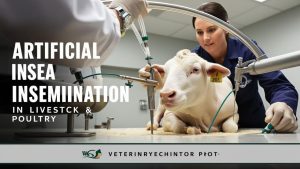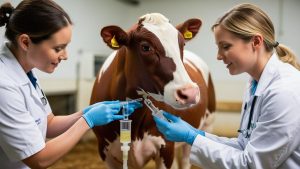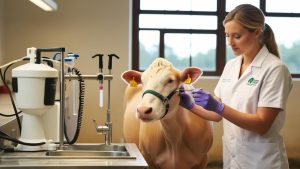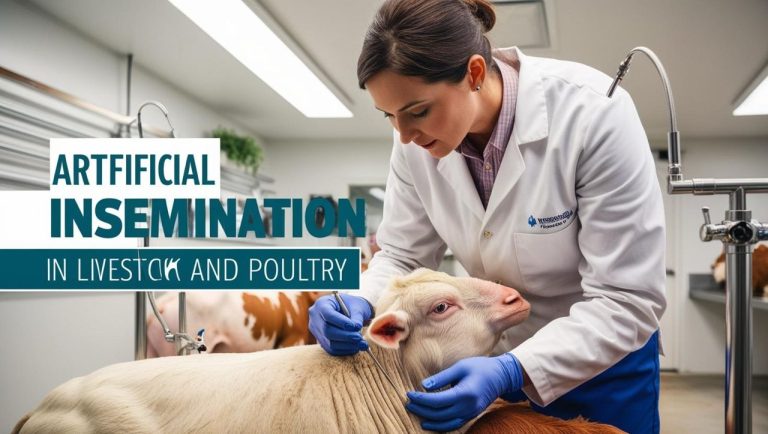Artificial Insemination (AI) is a widely used reproductive technology in livestock and poultry farming that involves the manual deposition of semen into the reproductive tract of a female animal using specialized equipment. AI has revolutionized breeding programs by improving genetic quality, enhancing productivity, and controlling diseases. This article explores the importance, methods, advantages, challenges, and management practices of artificial insemination in various livestock and poultry species.
Importance of Artificial Insemination
Click HERE to join our WhatsApp group
Artificial insemination plays a crucial role in modern animal production by offering several benefits, including:
Genetic Improvement: AI enables the use of high-quality semen from superior male animals, improving offspring traits such as milk yield, growth rate, and disease resistance.
Disease Control: Since AI eliminates direct mating, it reduces the spread of sexually transmitted diseases.
Cost-Effectiveness: AI reduces the need for maintaining multiple breeding males, thus lowering feeding and management costs.
Better Fertility Management: Farmers can control and optimize breeding seasons to enhance reproductive efficiency.
Increased Productivity: AI allows selective breeding, which improves overall herd or flock performance.
READ ALSO: Feed Processing and Preservation Techniques
Methods of Artificial Insemination

The AI procedure varies depending on the species. The key methods used in livestock and poultry are:
a) Artificial Insemination in Cattle
Semen Collection: Semen is collected from high-quality bulls using an artificial vagina or electroejaculation.
Semen Processing: Semen is analyzed for viability, diluted with extenders, and stored in liquid nitrogen (-196°C) for future use.
Insemination Process: A trained technician inserts the semen into the uterus using an AI gun.
Timing: AI is performed during estrus (heat period) for maximum conception rates.
b) Artificial Insemination in Sheep and Goats
Semen Collection: Fresh or frozen semen is used.
Insemination Techniques: Vaginal, cervical, or laparoscopic AI methods are used depending on the breed and semen quality.
Synchronization: Hormonal treatments are often used to synchronize estrus cycles for timed insemination.
READ ALSO: Salt Poisoning In Pig (must read for every pig farmers)
c) Artificial Insemination in Swine
Semen Collection: Collected from high-quality boars and stored at a controlled temperature.
Insemination: Semen is introduced into the cervix using a specialized AI catheter.
Benefits: AI allows the use of fewer boars while maintaining superior genetics across multiple sows.
d) Artificial Insemination in Poultry
Semen Collection: Rooster semen is collected manually.
Semen Dilution and Storage: Poultry semen is short-lived and is used fresh.
Insemination Process: AI is conducted by inserting semen into the oviduct of hens, usually weekly, to ensure fertilization.
Efficiency: AI in poultry increases hatchability and prevents mating-related injuries in large breeds like turkeys.
Advantages of Artificial Insemination

AI offers several advantages over natural mating, including:
Genetic Selection: AI allows breeders to use superior genetics without geographical limitations.
Higher Conception Rates: Timed insemination increases reproductive success.
Lower Risk of Injuries: AI eliminates aggressive mating behaviors.
Conservation of Endangered Breeds: AI helps preserve genetic diversity by storing semen for future use.
Increased Offspring Production: A single ejaculate can fertilize multiple females, maximizing reproductive efficiency.
READ ALSO: Best Ways to Avoid Mortality in Brooding
Challenges and Limitations of Artificial Insemination
Despite its benefits, AI has some challenges:
Technical Expertise: Requires trained personnel for successful insemination.
High Initial Costs: Equipment and semen storage facilities require investment.
Heat Detection Issues: Accurate estrus detection is essential for AI success.
Genetic Bottleneck: Overuse of a few elite males can reduce genetic diversity.
Semen Handling: Improper storage or handling can reduce fertility rates.
Best Practices for Artificial Insemination Management

To ensure successful AI, farmers should follow these management practices:
Proper Heat Detection: Monitor estrus signs like restlessness, mucus discharge, and mounting behavior.
Use of Estrus Synchronization: Hormonal treatments help synchronize breeding times.
Good Semen Handling Practices: Keep semen at the recommended temperature and use within the viable period.
Record Keeping: Maintain breeding records to track reproductive performance.
Regular Health Checks: Ensure females are in optimal reproductive condition before AI.
READ ALSO: Water-Based Feed Formulation for Ducks: A Comprehensive Guide
Future of Artificial Insemination in Livestock and Poultry
AI is evolving with advancements in reproductive technology:
Sexed Semen: Allows farmers to predetermine the gender of offspring, useful for dairy and meat production.
Genetic Engineering: AI combined with genetic selection can enhance desirable traits.
Automated AI Techniques: Technology-driven AI improves efficiency and accuracy.
Cryopreservation Advances: Improved semen storage techniques enhance long-term viability.
Conclusion
Artificial Insemination is a powerful tool for improving livestock and poultry production. By implementing AI, farmers can achieve better reproductive efficiency, disease control, and superior genetics. However, successful AI requires proper training, careful semen handling, and effective management practices. With continuous advancements in reproductive biotechnology, AI is set to play an even greater role in the future of animal agriculture.
READ ALSO: Common ways to manage bacteria diseases in poultry
Managing bacterial diseases in poultry is crucial to ensure the health and well-being of the birds and to maintain a productive and profitable poultry farm. Here are some common ways to manage bacterial diseases in poultry, along with details on each method:…
READ ALSO: Vaccination and Disease Prevention Strategies
Vaccination is one of the most effective methods of preventing infectious diseases in livestock and poultry. It protects animals from deadly infections, reduces mortality, and enhances farm productivity. Implementing comprehensive disease prevention strategies ensures sustainable animal farming…
Click HERE to join our WhatsApp group

